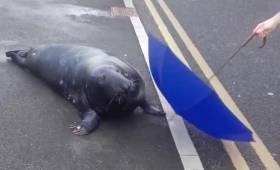Displaying items by tag: Sammy the Seal
'Sammy the Seal' Steals the Show With Ship-Side Survelliance
#CoastalNotes - During Afloat's visit to Wicklow Port this day last week, seemingly Sammy the Seal made a fleeting appearance when alongside a departing cargoship, writes Jehan Ashmore.
The departure that afternoon of Burhou-I involved the curious 'Sammy' or a fellow companion? make for inspection as the cargohip eased off slowly from the Packet Quay. On the next attempt to take a further zoomed-in photo, the seal slipped underneath the calm waters within Wicklow harbour.
Sammy the Seal has became something of a local celebrity in the town and beyond having gone 'viral' in recent years when footage showed the hungry grey seal 'visiting' the local fishmonger.
The presence of Sammy however, has become something of a nuisance, if you ask the staff of fishmongers, The Fishman on South Quay where local trawlers land catch. The fishmongers have to keep an eye on the mammal when crossing what can be a busy road before throwing him tasty fish scraps meals – one of three every day at high tide.
Returning to the port's commercial shipping activities, Burhou-I is engaged in the timber trade. The 674grt coaster is operated by Great Glen Shipping Co, Scotland from where round timber (logs) had been loaded for discharge in Wicklow Port.
Also in port this day last week was the cargoship's sister, Isis which this afternoon is bound for Wicklow Port having sailing from western Scotland. On board is more round timber having been loaded in Sandbanks, Holy Loch, located on part of the Cowal Peninsula along the Firth of Clyde.
Wicklow’s Hungry Seal Goes Viral Again
#MarineWildlife - Twitter user Derek Byrne was bemused by the sight of a large seal being chased from the door of a fishmonger’s as he drove through Wicklow town on Wednesday afternoon.
But for the townsfolk, Sammy the Seal has long been something of a local celebrity — or nuisance, if you ask the staff of The Fishman on South Quay.
They might well be saying that with tongue firmly in cheek, however, given that a sign across the street says ‘seal crossing’ and that T-shirts sporting an image of the gregarious seal can be purchased nearby, as the Guardian reports.
Just witnessed this giant seal being chased out the door of a fishmongers shop in Wicklow town. pic.twitter.com/WGlGxlAWfs
— Derek Byrne (@Derek1052) November 22, 2017
Indeed, Afloat.ie readers may remember when Sammy last appeared here in February 2016 — after one of his regular forays from the River Vartry for fishy snacks as thwarted at the end of an umbrella.
Yet despite the local fondness for Sammy, and the seal’s growing internet notoriety, Alan Hegarty of The Fishman and the adjacent Lighthouse Restaurant warns: “At the end of the day he is a wild animal and we want him to remain that way.”
























































